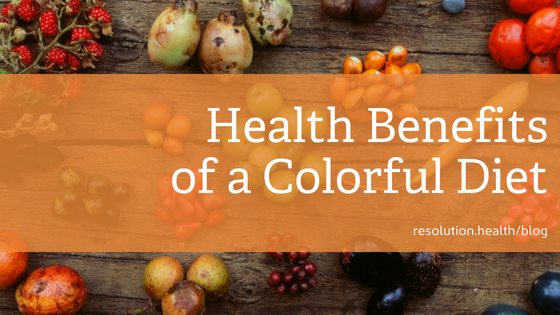Filling your plate with a lot of colors is about so much more than a nice presentation. Eating a variety of colors provides different nutrients to help boost immunity, prevent illness, reduce risk of disease, support energy levels, and support the body’s natural processes.
Brianna, RD, compiled this list of colorful foods and what they can do for you. If you’d like to see how a dietitian can make your meals more colorful and nutritious, book a free 15-minute consultation.
RED
Studies have linked the anthocyanins, ellagic acid, and lycopene found in these red foods with preventing or fighting cardiovascular disease and cancer, improving mental functions, or treating infections.
- Anthocyanins: raspberries, strawberries, cherries, apples, beets, red pepper, kidney beans, cabbage, adzuki beans, red onion.
- Ellagic acid: pomegranate, strawberries, raspberries, cherries. As an antioxidant, it is used for preventing cancer, improving mental functions, and treating infections.
- Lycopene: tomato, watermelon, guava, grapefruit.
ORANGE
Carotenoids are thought to decrease the risk certain cancers and eye disease. Flavanoids have been linked with reduced risk of a number of chronic diseases, including cancer, cardiovascular disease and neurodegenerative disorders.
- carotenoids (beta carotene): orange pepper, habenero, carrots, acorn and butternut squash, pumpkin, sweet potato, mango, cantelope, oranges, papaya
- flavanoids/polyphenols (curcumin, naringenin): turmeric, citrus fruit
YELLOW
- carotenoids (lutein, zeaxanthin): corn, honeydew melon, mango, summer and spaghetti squash.
GREEN
Studies suggest that glucosinaolates help protect against cancers of the lungs and intestines. Chlorophyll is used for treating wounds and as an “internal deoderant.” Isoflavones may protect against age-related diseases, like cardiovascular disease, osteoporosis, cancer, and loss of cognitive function. Phytosterols reduce total blood cholesterol and LDL cholesterol levels. Catechins are natural antioxidants that help prevent cell damage.
- glucosinolates: cruciferous veggies, such as broccoli, brussels sprouts, collard greens, kholrabi, kale, mustard greens, chard
- chlorophyll: spinach, parsley, watercress, arugula, leeks, sugar snap peas, green beans
- isoflavones: edamame (plus soymilk, tofu, tempeh (soy))
- phytosterols: olive oil
- catechins: green tea
BLUE/PURPLE
Resveratrol is used in the prevention of cardiovascular disease, but is also linked with anti-cancer benefits and protection from neurodegenerative disorders.
- anthocyanins: blueberries, blackberries, aronia berries, elderberry, figs, grapes, prunes, plums, eggplant
- resveratrol: grapes, red wine, blueberries, dark chocolate
WHITE/TAN/BROWN
Allicin can be useful as an antimicrobial substance, and to prevent and treat cardiovascular disease. Lignans have long been associated with reducing the risk of cardiovascular disease. And chlorogenic acid is linked to antibacterial, antioxidant, and anticarcinogenic activities.
- allicin: garlic, onions, leeks, chives
- lignans: flax, chia, nuts/seeds
- chlorogenic acid: coffee, tea
Sources:
- https://www.ncbi.nlm.nih.gov/pmc/articles/PMC3850026/
- https://www.ncbi.nlm.nih.gov/pubmed/12134711
- https://www.ncbi.nlm.nih.gov/pubmed/15678717
- https://www.ncbi.nlm.nih.gov/pubmed/11887749
- https://lpi.oregonstate.edu/mic/dietary-factors/phytochemicals/chlorophyll-chlorophyllin
- https://www.ncbi.nlm.nih.gov/pubmed/18815737
- https://www.ncbi.nlm.nih.gov/pubmed/12587987
- https://www.ncbi.nlm.nih.gov/pmc/articles/PMC2546476/
- https://www.ncbi.nlm.nih.gov/pmc/articles/PMC4103721/
- https://www.ncbi.nlm.nih.gov/pubmed/10594976
- https://lpi.oregonstate.edu/mic/dietary-factors/phytochemicals/lignans#disease-prevention
- https://www.ncbi.nlm.nih.gov/pmc/articles/PMC3766985/
